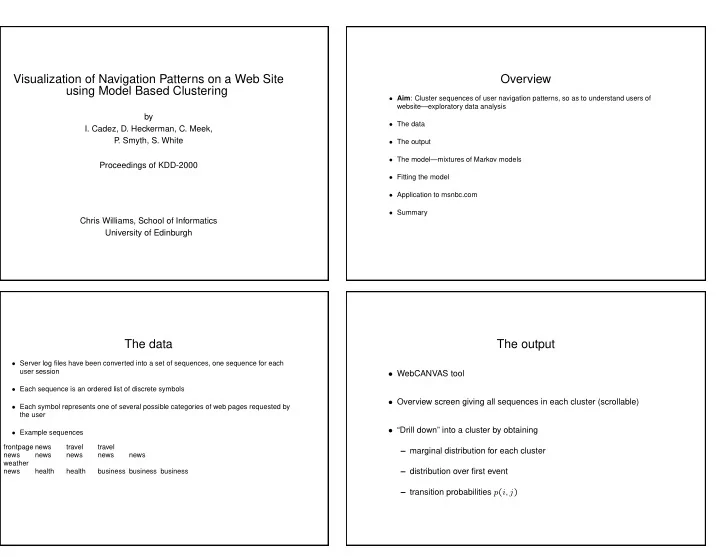

Visualization of Navigation Patterns on a Web Site Overview using Model Based Clustering • Aim : Cluster sequences of user navigation patterns, so as to understand users of website—exploratory data analysis by • The data I. Cadez, D. Heckerman, C. Meek, P . Smyth, S. White • The output • The model—mixtures of Markov models Proceedings of KDD-2000 • Fitting the model • Application to msnbc.com • Summary Chris Williams, School of Informatics University of Edinburgh The data The output • Server log files have been converted into a set of sequences, one sequence for each user session • WebCANVAS tool • Each sequence is an ordered list of discrete symbols • Overview screen giving all sequences in each cluster (scrollable) • Each symbol represents one of several possible categories of web pages requested by the user • “Drill down” into a cluster by obtaining • Example sequences frontpage news travel travel – marginal distribution for each cluster news news news news news weather – distribution over first event news health health business business business – transition probabilities p ( i, j )
The model Fitting the model • Mixture of Markov models • Use EM (penalized maximum likelihood) • Initialize π ’s all equal K � p ( x | θ ) = π k p ( x | θ k ) • Initialize θ ’s by fitting a single Markov model, then perturbing these parameters in each i =1 component L � p ( x | θ k ) = p ( x i | θ I p ( x i | x i − 1 , θ T k ) k ) • Do 20 restarts for each K , choose model with highest posterior probability i =2 • Choose K using log likelihood of hold-out data • θ I k is probability of the initial symbol in the sequence (multinomial) • θ T k is the transition probability from x i − 1 to x i ; each row is a multinomial • Can also use a zeroth-order Markov model (unigram model) p ( x | θ k ) = � L i =1 p ( x i | θ U k ) A small problem, and a solution Application to msnbc.com • Two or more clusters can be encoded by a single Markov model • 100,023 training sequences, 98,687 validation seq • Example: start at a then choose between b and c , or start at d then • Found that EM scaled linearly with N (number of sequences) and K choose between e and f • Best first-order model has 40 components • This problem occurred frequently • Chose constrained model with 100 components (of course constrained • Solved by allowing only one non-zero probability start state model needs more components)
Summary • Mixture of first-order Markov models • WebCANVAS tool to visualize the clustered data and models • Found that this clustering has revealed numerous interesting insights
Recommend
More recommend